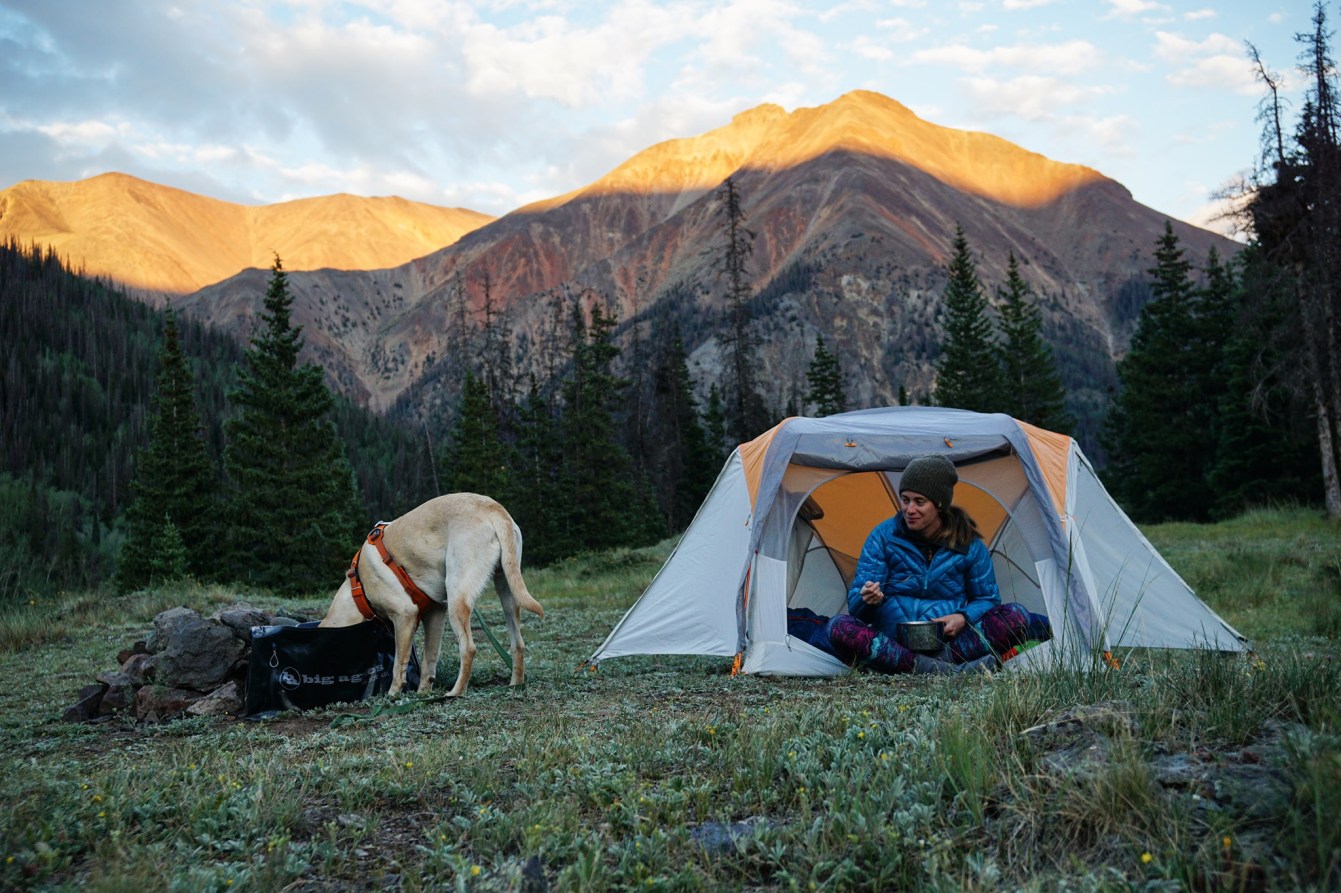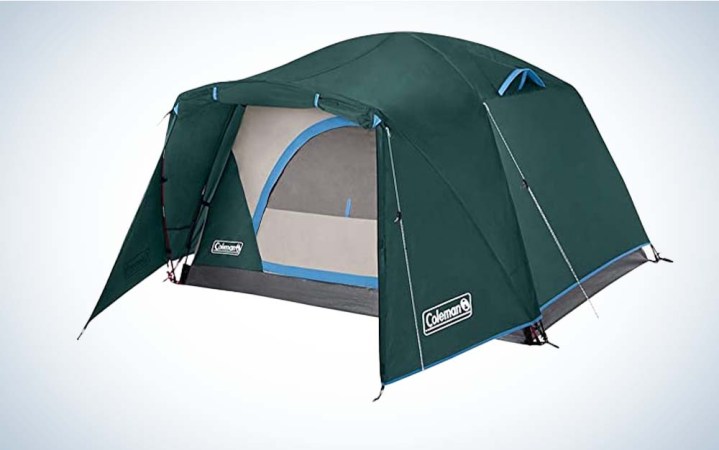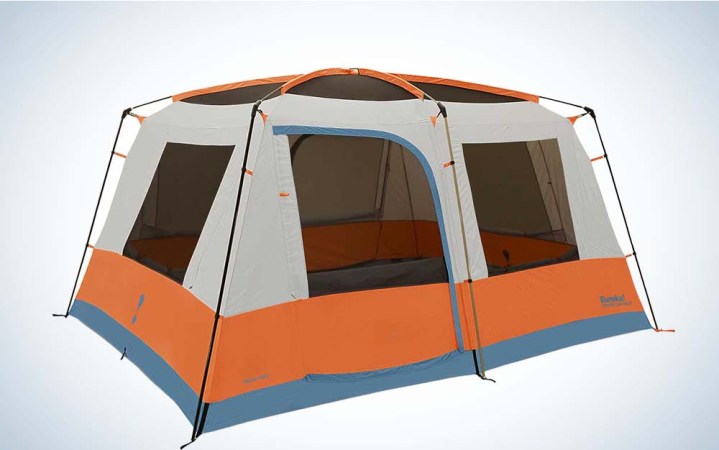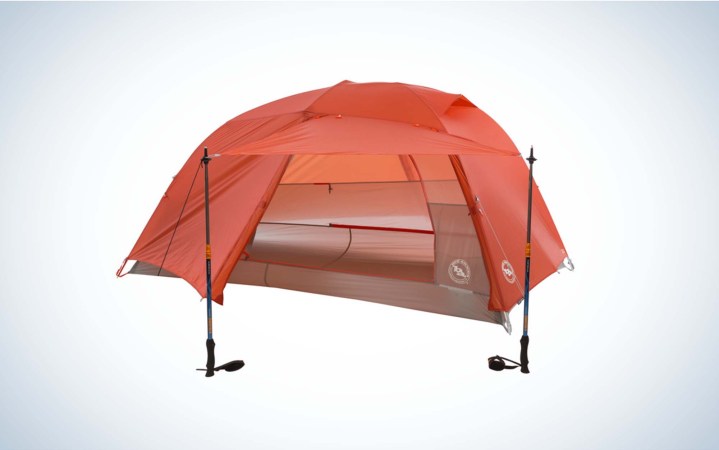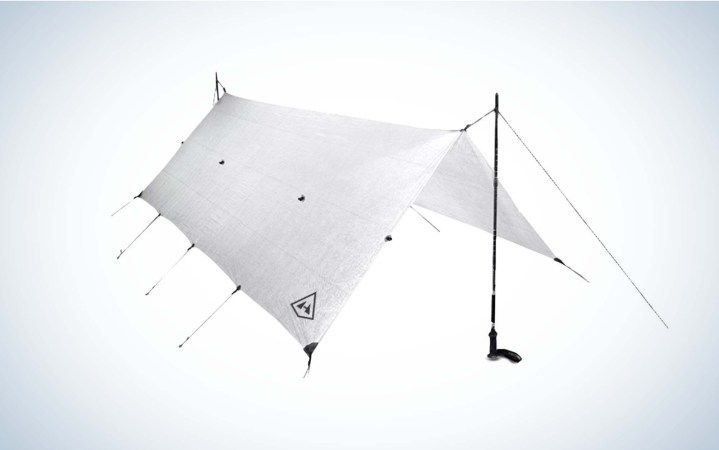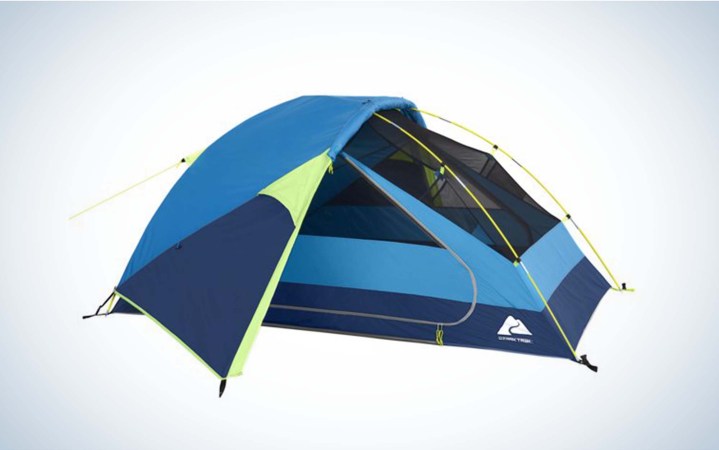We may earn revenue from the products available on this page and participate in affiliate programs. Learn More ›
If you’ve ever let the family pooch hop on your bed for the night, you’ll know that the moniker “man’s best friend” doesn’t necessarily extend to the witching hour. But, if you’re like us, the idea of banishing your dog to outside the tent seems too extreme, especially if you’re concerned they might not stay put should some interesting wildlife wander into camp. To ensure you get enough sleep for the night, you’ll need a camping tent that can accommodate the two of you (or more, if your best friends come in pairs). Fortunately, we’ve tested some of the best family camping tents available today to bring you the best tents for camping with dogs:
- Best Overall: Coleman Skydome 2-Person Camping Tent
- Best for Multiple Dogs: Eureka Copper Canyon LX8
- Best for Backpacking: Big Agnes Copper Spur HV UL2
- Best Camping Tarp: Hyperlite Mountain Gear Ultralight Flat Tarp
- Best Budget: Ozark Trail 2-Person Backpacking Tent
Things to Consider Before Buying a Tent for Camping with Dogs
Purpose
Campers can expect to face a variety of conditions depending on the time of year and the part of the country they are exploring, so knowing the extremes of your climate is essential to choosing the best tents for camping with dogs. The tents in this selection are three-season tents, which are appropriate for summer and shoulder-season conditions.
Set-Up
The majority of two-person tents on the market are freestanding, which are a great choice for camping with dogs, as they resist falling down with accidental bumps and jumps better than their non-freestanding counterparts.
Weight
Car camping tents, including pop-up tents and rooftop tents, are bulky. Even the lightest models weigh upwards of five pounds per person. Backpacking tents are much lighter and typically weigh less than three pounds per person, with some ultralight (UL) models approaching one pound or less. There is usually a tradeoff with weight savings for durability and price with backpacking tents. Backpackers focused on short trips with their dogs may prefer a heavier option (especially if their dog is less gentle with gear).
Size
While many two-person tents are a tight squeeze for two people, most are the ideal size for one person and one dog—even accommodating gear at the bottom of the tent once your pup is curled up on their sleeping mat.
Best Overall: Coleman Skydome 2-Person Camping Tent
Key Features
- Weight: 9 pounds, 10 ounces
- Floor dimensions: 84 inches x 60 inches
- Peak height: 48 inches
- Number of poles: 3
Why It Made the Cut
The durable tarp floor of the Coleman Skydome is easy to clean up after your dog inevitably tracks dirt into the tent, while the square footage (which is on the larger size for a two-person tent) could easily accommodate multiple dogs.
Pros
- Low price
- Heavy-duty bathtub floor excels at keeping puddles at bay
- Great awning for drying off your pooch before letting them into the tent
Cons
- Small vestibule door
- Fly setup is less straightforward than the body
Product Description
If your pooch tends to monopolize your bed, then the Coleman Skydome might be what you need to get a full night of sleep on your next camping trip. Its impressive floor space—35 square feet, large enough for a queen-size sleeping pad and them some—could easily accommodate multiple dogs (although likely not multiple large dog crates), while its steep sides and four-foot ceiling height mean that you won’t have to worry about getting squeezed into a claustraphobic position overnight.
The drawback of this tent is that it was less intuitive to set up than others I’ve tried. I had to go back to the directions multiple times to figure it out. The two poles, which are connected to the tent body (a boon to anyone who has ever forgotten their poles at home) snapped into place with the end sliding easily into a pouch on the opposite corner and the tabs clicking into place—so you can at least get a doggy bed set up inside if someone is ready to crash after a long day of hiking or chasing squirrels. But when it came time to put on the rainfly, it took some searching to figure out where the pole slid into on the underside of the rainfly. That being said, this is one of the best awnings I’ve ever seen on a two-person tent, with plenty of space to shelter your dog for a quick towel shakedown before coming inside on a muddy day.
Best for Multiple Dogs: Eureka Copper Canyon LX8
Key Features
- Dimensions: 13 feet x 10 feet
- Height: 7 feet
- Weight: 33.5 pounds
- Poles: 10
- Packed Size: 11 inches x 29 inches
- Doors: 2
Why It Made the Cut
A spacious interior and great weather durability made the somewhat complicated setup of the Copper Canyon LX8 more than worth it.
Pros
- Great livable space on the interior
- Able to withstand both rain and wind
- Lots of doors and windows
Cons
- An unusually complicated setup
- Heavy
Product Description
If your family of four also includes two dogs, then you’ll need something more than a simple four-person tent. The eight-person tent from Eureka is a great choice because it not only maximizes interior square footage with a quite liveable 13-foot x 10-foot layout, but it also has an unusually impressive head height—7 feet—which helps to make the tent feel larger than it actually is—nice when you’re sharing it with a crowd.
During testing, I was also impressed with how weather resistant this tent was, repelling both 25 mph gusts of wind and staying dry inside during an overnight rainstorm. The only downside to this tent is that it is an unusually complicated setup. Three fiberglass poles crisscross the ceiling and then connect to six steel poles at each end to form the walls (the tenth pole creates the awning over the doorway). The directions for this were reasonably easy to follow—it just took a while. While I was able to set up the body of this tent by myself, a second (taller) person was needed to add the rainfly.
Best for Backpacking: Big Agnes Copper Spur HV UL2
Key Features
- Weight: 2 pounds, 11 ounces
- Floor dimensions: 88 inches x 52 inches with a tapered foot
- Peak height: 40 inches
- Number of poles: 2
Why It Made the Cut
The Copper Spur is light enough that it’s still a reasonable choice for backpacking after you add on the floor protector (sold separately).
Pros
- Lightweight
- Packs down small
- Fast and easy setup
- A floor protector (sold separately) protects your tent from doggy wear and tear
Cons
- Expensive
Product Description
Most traditional backpacking tents aren’t built to withstand dog claws. But purchasing a completely separate tent just for backpacking with your pooch is a major expense for most outdoorsmen and women—one that all too often leads to the pupper being left at home. Fortunately, one of the most popular backpacking tents on the market, the Big Agnes Copper Spur UL2, has a tent floor protector (sold separately), which goes inside of your tent to provide extra protection from pup as they settle down for the night. While the floor protector is a bit on the heavy side at almost two pounds, the sub 3-pound weight of the tent on its own makes this a reasonable choice for trekking into the wilderness with no one but your four-legged companion.
Best Camping Tarp: Hyperlite Mountain Gear Ultralight Flat Tarp
Key Features
- Weight: 8.9 ounces
- Dimensions: 8 feet x10 feet
- Peak Height: depends
- Number of Poles: 2
Why It Made the Cut
This sub one pound tarp uses trekking poles to maximize an interior space that will comfortably fit you and your pooch.
Pros
- Extremely lightweight
- Extremely packable
Cons
- Expensive
- Requires experience to set up correctly
Product Description
Even a lightweight two-person tent can be too heavy to carry into the wilderness when you’re packing everything for two in your own bag. So if you’re trying to achieve a respectable ultralight baseweight while carrying enough kibble for a few days in the wilderness, it might be time to ditch the floor of your tent, and the doors—and the poles. What you’re left with is something that more closely resembles a doghouse than a backpacking tent, but your number two isn’t going to mind, and after a couple of nights curled up next to them, we don’t think you will either. The Hyperlite Mountain Gear Flat Tarp is a great choice for ultralight backpacking with dogs, as, even with its fully bonded seams and excellent UV resistance, it doesn’t crack nine ounces (assuming you’ve brought along some trekking poles to help support the interior space). With innumerable configurations, there is a variation for just about any three-season condition you anticipate encountering, but the trick is that you’ll need to master the art of the setup to ensure you and your four-legged friend stay dry, and your shelter stays erect, when conditions start to really pick up.
Best Budget: Ozark Trail 2-Person Backpacking Tent
Key Features
- Weight: 7 pounds, 9 ounces
- Floor dimensions: 90 inches x 54 inches
- Peak height: 42 inches
- Number of poles: 3
Why It Made the Cut
A bargain basement price combined with basic functionality makes this a serviceable option for anyone unsure of how their pooch will respond to the great outdoors.
Pros
- Extremely low price
- Durable floor that doesn’t need a groundsheet
Cons
- Heavy
- Not built for serious conditions
- Lack of a bathtub floor could allow moisture to seep in
Product Description
Going into the great outdoors is all about discovery. How many miles can I walk in a day? Will I be too cold winter camping? How many pairs of the best hiking socks do I need, anyway? The same goes for your best friend: there is no way to know, really, how they will respond to camping until you try it.
If you’re looking to try out camping with your dog, but don’t want to spend hundreds of dollars on equipment, then the Ozark Trail 2-Person Backpacking Tent is a great place to start. It’s made out of more substantial material than many of the other tents on this list (this would never make the cut in a lightweight backpacking setup), although there are some weatherproofing issues—the stitching is considerably thicker and looser, suggesting that this tent may let in some water in the wrong conditions, and the tarp floor doesn’t wrap up around the sides). If you’re testing the waters of camping with your dog during the dog days of summer, it will do fine, but maybe postpone a weekend or two if the forecast calls for anything more substantial than a drizzle.
FAQs
Two-person tents range in cost from less than $50 to upwards of $500, with larger tents costing as much as $1,000. These price differences typically reflect the quality of material and construction, and, in the case of backpacking tents, weight differences.
While two people and a dog cannot fit into a two-person tent, one person and a dog are a great fit for a two-person tent.
The first, and most obvious, way to protect your tent from your dog is to not leave them alone in it unsupervised. Tents are made to be lightweight, with a low packed profile, and resist wind, rain, and sometimes even snow—but not your four-legged friend. The most vulnerable part of a tent to a dog is the floor, and there are a few ways you can prevent excessive damage from occurring. The first is the corollary to the strategies that campers and backpackers use to protect their tent floor from the rocks and roots of the ground—a groundsheet. Some simply use a second groundsheet inside their tent, while others cut out a piece of Tyvek (which is durable, lightweight, and waterproof), while still others will bring along a blanket or camping pad for specifically this purpose. The second way to protect your tent floor from your dog is through careful grooming, both clipping their nails before your next camping trip and filing down the sharp edges.
While the minimum temperature that you can safely take a dog camping varies tremendously by breed (and age), it’s best to start with camping trips where the nighttime temperatures aren’t projected to fall below fifty degrees Fahrenheit. If you’re concerned that your pooch will be cold, there are several things you can do to make them more comfortable. The first is to ensure that your dog is insulated from the cold of the ground by getting them one of the best backpacking sleeping pads with an R rating. Many closed-cell foam mattresses provide an R rating of 2 or higher, which is appropriate for summer camping. The next strategy would be to ensure you are sharing some body heat with your dog overnight by allowing them to curl up next to you (something they’ll be inclined to do anyway inside of a cozy tent). Keep in mind that, more often, dogs struggle with the heat while car camping more than they do the cold. Have plenty of water and shade available for your pooch, and encourage them to rest with you during the heat of the day.
Methodology
I’ve tried, and watched others try, numerous tents over hundreds of nights in nine different states, covering everything from alpine meadows to old-growth forests, long-distance backpacking to casual car camping. I’ve had my fair share of mishaps in tents, from getting flooded out in Southern California to being blown off a sand dune outside of Death Valley, to bringing the wrong poles for my winter tent during a snowshoeing overnight in Olympic National Park. Along the way, I’ve advised first-time campers on the best way to share a tent with their dog, as well as loaned gear for that purpose. Our tents for camping with dogs come from testing the Outdoor Life gear team did for the best backpacking tents, best camping tarps, best two-person tents, and best eight-person tents.
Final Thoughts
There are a wide range of options for the best tents for camping with dogs. We recommend choosing the best quality tent that your budget allows, as the weight-savings and reliability will pay dividends over the years.
